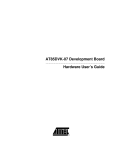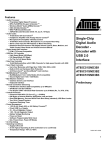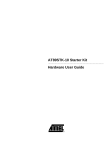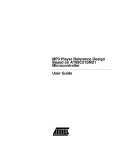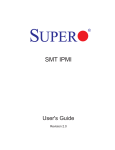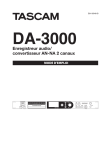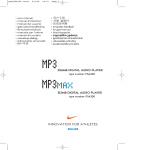Download Atmel AT85DVK-07 User`s manual
Transcript
AT85DVK-07 Demonstration Firmware ....................................................................................................... User’s Manual Section 1 Introduction ........................................................................................... 1-1 Section 2 Getting Started...................................................................................... 2-3 2.1 Features ....................................................................................................2-3 2.1.1 System................................................................................................2-3 2.1.2 Audio Player .......................................................................................2-3 2.1.3 USB Device ........................................................................................2-3 2.1.4 USB Host............................................................................................2-4 2.1.5 File System.........................................................................................2-4 2.1.6 Sound Control.....................................................................................2-4 2.1.7 Firmware upgrade ..............................................................................2-4 2.2 2.3 Keypad Description ...................................................................................2-5 Power-Up ..................................................................................................2-6 Section 3 Operating Modes .................................................................................. 3-7 3.1 Main Menu ................................................................................................3-7 3.1.1 Operating Modes ................................................................................3-7 3.1.2 Battery Status .....................................................................................3-7 3.1.3 USB Host Status.................................................................................3-7 3.2 Player ........................................................................................................3-8 3.2.1 Player Status ......................................................................................3-8 3.2.2 Contextual Menu ................................................................................3-9 3.3 Mass-Storage..........................................................................................3-11 3.3.1 3.4 Contextual Menu ..............................................................................3-11 Explorer...................................................................................................3-12 3.4.1 USB Host..........................................................................................3-12 3.4.2 Contextual Menu ..............................................................................3-12 3.5 3.6 3.7 Ebook ......................................................................................................3-14 CDC demo ..............................................................................................3-14 Playlist.....................................................................................................3-15 3.7.1 Contextual Menu ..............................................................................3-15 3.8 Recorder .................................................................................................3-16 3.9 Games ....................................................................................................3-16 3.10 Settings ...................................................................................................3-17 3.10.1 Language..........................................................................................3-17 3.10.2 Power ...............................................................................................3-17 3.10.3 Format ..............................................................................................3-17 3.10.4 Version .............................................................................................3-17 AT85DVK-07 Demonstration Firmware User’s Manual 1 7687C–MP3–09/07 Table of Contents 3.10.5 Update System .................................................................................3-17 3.10.6 Update Settings ................................................................................3-17 3.10.7 Exit....................................................................................................3-17 3.11 Firmware Update ....................................................................................3-18 3.11.1 Automatic Firmware Update .............................................................3-18 3.11.2 Manual Firmware Update .................................................................3-18 2 7687C–MP3–09/07 AT85DVK-07 Demonstration Firmware User’s Manual Section 1 Introduction The AT85C51SND3B is a low power single-chip highly-integrated digital audio decoder/encoder for applications such as audio players, recorders, cell phones, toys, etc. The AT85C51SND3B MP3 Player firmware is part of the AT85DVK-07 Development Kit dedicated to the AT85C51SND3B microcontroller. The firmware is delivered with a set of MMI applications which form an overall demonstration MP3/WMA player. This document is the User’s Manual of the AT85C51SND3B MP3 Player application based on the AT85DVK-07 Development Board. It describes the demonstration firmware and its basic operating modes based on the 1.9.4 firmware version: snd3b-dvk1_9_4. AT85DVK-07 Demonstration Firmware User’s Manual 1-1 7687C–MP3–09/07 Section 2 Getting Started 2.1 2.1.1 Features System The following is a list of features supported by the demonstration firmware: • Display – 128x64 graphical monochrome LCD – LED backlight • Memories – 256MB Nand Flash on-board memory Driver ready up to 4GBytes (4 dies) – MMC / MMC V4 - 1bit/4bits mode – SD / SD HC - 4bits mode – USB disk (U-drive) through USB host 2.1.2 Audio Player • Audio Stream – MP1, MP2, MP3 – WMA – WAV (PCM, G711, G726) Playback • Recording – G726 • Repeat A/B • Play, Pause, Stop • Next track, Previous track • Fast Forward, Fast Rewind • Speed Adjust (MP1, MP2, MP3 only) • Tags – ID3 v1.0, v1.1 – ID3 v2.2 and v2.3 2.1.3 USB Device • USB 2.0, High Speed Transfer • Supported Class: Mass Storage, HID, CDC. • Mass Storage, transfer rate performance: – typical, 10MB/s read - 8MB/s write on NandFlash – up to 12MB/s on MMC V4 / SD / SD HC AT85DVK-07 Demonstration Firmware User’s Manual 2-3 7687C–MP3–09/07 Getting Started 2.1.4 2.1.5 2.1.6 USB Host File System Sound Control • Reduced Host Implementation • USB 2.0, Full Speed Transfer • Supported Class: Mass Storage, HUB, HID, CDC. • Mass Storage rate performance is 1MB/s (maximum of Full Speed) • FAT12, FAT16, FAT32 • More than one file/disk opened at a time • File copy/paste/create/delete • Directory create/delete • Format • Stereo volume control • Sound effects: – Bass Boost – Spatial sound • Adjustable 3-band EQ – Classic, Pop, Jazz, Rock... 2.1.7 Firmware upgrade • Upgrade through update file drag and drop • Automatic Upgrade – From Nand Flash disk – From MMC/SD disk • 2-4 7687C–MP3–09/07 No PC tool install required AT85DVK-07 Demonstration Firmware User’s Manual Getting Started 2.2 Keypad Description The following figure shows the basic key functions. Up Select Vol Up Lock F1 Vol Down Function F1 F2 Menu Power On Left Right Down • Lock: this switch is the keypad hold function: push right to lock, left to unlock. • F1: this is special key whose function depends on the operating modes. • Vol Up: press to increase the sound volume. • Vol Down: press to decrease the sound volume. • Menu: this key displays a contextual graphical menu. The icons displayed in this menu vary depending on the operating mode. Refer to the Section 3 for further information. • Power On: this key is used to power-up the system when a battery is inserted in its socket. • Joystick: this mini joystick has 5 functions: Up, Down, Right, Left, Select which vary depending on the operating mode. Select corresponds to the joystick center pressing. AT85DVK-07 Demonstration Firmware User’s Manual 2-5 7687C–MP3–09/07 Getting Started 2.3 Power-Up There are two ways to power-up the system: • USB powered: the USB cable is connected to the board and to a PC • Battery Powered: a battery is inserted in its socket, the Power On key is pressed. Note that the battery can be replaced by an external power-supply connected to J20 (see the AT85DVK-07 Hardware User’s Guide for further information). A short animation followed by the Atmel logo will be displayed during few seconds, giving the version of the firmware and NandFlash manufacturer IDs: NandFlash Manufacturer ID NandFlash Device ID Note: To skip the display, press a key. If the board is powered using the battery, the Main Menu application is launched: If the board is powered by the USB cable (device mode), the Mass-Storage application is automatically launched: 2-6 7687C–MP3–09/07 AT85DVK-07 Demonstration Firmware User’s Manual Section 3 Operating Modes 3.1 Main Menu The main menu shows the operating modes of the player. Application name USB Host Status Magnified application icon Battery Status The operating mode is selected using the Right and Left keys, then launched by pressing the Select key. 3.1.1 3.1.2 Operating Modes Battery Status Here is the list of the operating modes. Their description is given in the following sections: Mass Storage Explorer Player Play list Games Recorder Settings Ebook CDC demo The battery status can take the following states: Battery Full Battery medium Full Battery Low Battery Very Low Battery Charging (animated) 3.1.3 USB Host Status The USB host status can take the following states (empty zone = no device detected): USB device detected HUB device detected Mass Storage device detected HID device detected CDC device detected AT85DVK-07 Demonstration Firmware User’s Manual 3-7 7687C–MP3–09/07 Operating Modes 3.2 Player The easiest way to play the Nand Flash disk is to select the player operating mode. From the main menu, select the player icon, then confirm by pressing the Select key. The player will automatically start playback of all songs in the Nand Flash and MMC (if present) disks or from the last saved position (file + played time) if file still exists. Stream Type Index/Total song in current directory File Name ID3 Song Name ID3 Singer Name Stream Bit-Rate Play Time Player Status If the MP3 file contains ID3 tags, they are automatically displayed. 3.2.1 Player Status The player status can take the following states: Play Pause Stop Fast Forward Fast Rewind Play A TAG Set Repeat AB Sequence 3.2.1.1 Playing Control To toggle Play and Pause mode: • Press the Select key briefly. To Stop the player: • 3.2.1.2 Song Selection 3.2.1.3 Fast Forward Fast Rewind 3.2.1.4 Repeat AB 3.2.1.5 Volume Control Press the Select key and keep it pressed (long press). To skip the current played song: • Press the Right Key briefly to play to the next song. • Press the Left Key briefly to skip to the previous song. To quickly go forward or backward inside the audio stream: • Press the Right key and keep it pressed to enter fast forward play mode. • Press the Left key and keep it pressed to enter fast rewind play mode. To setup a repeat AB sequence, perform the following key sequence: • Press the F1 key to set the A marker • Press the F1 key again to set the B marker and restart play back to the A marker • Press the F1 key again to cancel the repeat sequence To increase or decrease the audio volume: • Press the Vol-Up key or Up key to increase the volume. • Press the Vol-Down or Down key to decrease the volume. A pop-up windows appears which gives information on volume level: 3-8 7687C–MP3–09/07 AT85DVK-07 Demonstration Firmware User’s Manual Operating Modes 3.2.2 Contextual Menu A contextual graphical menu is invoked by pressing the Menu key: Scroller Menu Press the Menu key again to remove the menu. Once the menu is displayed, press the Up or Down keys to select one of the following functions: Main Menu Equalizer Modes Speed Adjust Confirm your choice by pressing the Select key. 3.2.2.1 Main Menu Executing this function exits the Player application and go back to the Main Menu. 3.2.2.2 Equalizer Executing this function launches the equalizer application. The following menu appears: To select the Bass Boost, simply selects the BBE option with the Up or Down keys and press the Select key to toggle the effect on and off. To select the Spatial effect, selects the 3D option with Up or Down keys and press the Select key to toggle the effect on and off. The currently selected ambiance is displayed (“Flat” in the above picture). To change it, select the ambiance option with Up or Down keys and press the Select key. The following pop-up appears: Press the Up or Down key to select another ambiance (club, jazz, …). Press the Left key to go back to the previous menu. You can also define you own ambiance setting by selecting the User ambiance. Select one of the band (BASS, MED, TREB) using Left or Right, then adjust the band using the Up or Down keys. Press the Select key to exit from this feature. AT85DVK-07 Demonstration Firmware User’s Manual 3-9 7687C–MP3–09/07 Operating Modes 3.2.2.3 Modes Executing this function launches the player mode application. The following menu appears: Select the fields “Mode” “Repeat” or “Random” using Up or Down keys. Change the selected field value using Left or Right keys. • Mode field values: – “DiskS”, the player plays all song files of each disks (NF, MMC, USB). – “Disk”, the player plays all song files of current disk. – “Dir only”, the player plays all song files of current folder only. – “Dir + Sub”, the player plays all song files of current folder and the subs folders. – “Play list”, in play list mode only and this value can not be changed. • Repeat field values: – “Normal”, at the end of list the player stop – “Repeat single”, at the end of current file the player restart the play of same file – “Repeat all”, at the end of list the player restart the play at the first file of list – “Single”, at the end of current file the player stop • Random field values: – On – Off 3.2.2.4 Speed Adjust 3-10 7687C–MP3–09/07 Executing this function once, reduces the play-back speed, executing the function again returns to the normal play-back speed (available only for MP1, MP2, M3 streams). AT85DVK-07 Demonstration Firmware User’s Manual Operating Modes 3.3 Mass-Storage To enter the USB disk Mass-Storage application, selects the storage icon from the main menu: Status Activity The Nand Flash memory and MMC/SD card are seen as regular removable disks. Access is done using the Windows explorer. The Flash disk activity is shown on the display, as well as an icon on the upper right corner giving status of the USB: USB is busy USB is idle 3.3.1 Contextual Menu To enter the contextual menu, follow the sequence described in Section 3.2.2. Once the menu is displayed, press the Up or Down keys to select one of the following functions: Main Menu Confirm your choice by pressing the Select key. 3.3.1.1 Main Menu Executing this function exits the Mass-Storage application and go back to the Main Menu. On top of the contextual menu, a shortcut (F1 key) allows to switch to the Player application without going-back to the Main Menu. The Play-back will start from the root directory or from the last saved position (file + played time) if file still exists. AT85DVK-07 Demonstration Firmware User’s Manual 3-11 7687C–MP3–09/07 Operating Modes 3.4 Explorer To enter the Explorer application (disk selection screen), select the Explorer icon from the main menu:. Disk A: stands for the Nand Flash memory; while disk B: stands for the MMC/SD card. Navigation is intuitive: press the Right key to enter into a disk or a directory, the Left key to go back to the upper folder. Press the Up and Down keys to navigate into the files. To play a disk, a folder or a file, put the cursor on the corresponding location with the joystick, then press the Select key. The explorer will automatically launch the player module on the selected disk/folder/file. Note: 3.4.1 USB Host The playback will only be made inside the selection. At its end, the player will restart on the first file of the selection. In case a USB mass-storage device is connected to the board (refer to the procedure described in the AT85DVK-07 Hardware User’s Guide), a new disk is mounted in the explorer: Disk C to Z: stands for the USB devices, Host status is displayed on the bottom of the screen according to Section 3.1.3. 3.4.2 Contextual Menu To enter the contextual menu, follow the sequence described in Section 3.2.2. Once the menu is displayed, press the Up or Down keys to select one of the following functions: Main Menu Disk Selection Select Playlist Add to Playlist Copy Paste Delete Format Properties Confirm your choice by pressing the Select key. 3-12 7687C–MP3–09/07 AT85DVK-07 Demonstration Firmware User’s Manual Operating Modes 3.4.2.1 Main menu Executing this function exits the Explorer application and go back to the Main Menu. 3.4.2.2 Disk Selection Executing this function jumps back to the disk selection screen (A:, B:, …) 3.4.2.3 Select playlist Executing this function to select the current file as the current playlist. Support text list files and m3u files (ASCII and UNICODE). 3.4.2.4 Add to playlist Executing this function adds a disk, a folder or a file into the current playlist. If no playlist is selected via “Select playlist” then a default list is created “A:\playlist\playlist001.m3u”. 3.4.2.5 Copy Executing this function marks a file to copy. Put the cursor on the corresponding location with the joystick then display the scroller menu and select the “Copy” function. 3.4.2.6 Paste Executing this function pastes the file previously marked by the copy function in the current location. Put the cursor on the destination location where to paste the file, then display the scroller menu and select the “Paste” function. 3.4.2.7 Delete Executing this function deletes the file. Put the cursor on the corresponding location with the joystick then display the scroller menu and select the “Delete” function. 3.4.2.8 Format Executing this function format the selected disk. Put the cursor on the corresponding disk with the joystick then display the scroller menu and select the “Format” function. 3.4.2.9 Properties Executing this function split display in two space: • the property zone with date and size of the selected item (disk/file/folder) • the explorer zone displaying only 2 entries AT85DVK-07 Demonstration Firmware User’s Manual 3-13 7687C–MP3–09/07 Operating Modes 3.5 3.6 Ebook CDC demo To enter the Ebook application, select the Ebook icon from the main menu. The explorer application is launched with text file filter (*.txt) and you can select a text file to display its content. When the text file is displayed, you can press the Up or Down keys to display previous or next page of text file. Press the Menu key to exit. To enter the CDC demo application, select the CDC icon from the main menu. The following pop-up is launched: CDC device state received string from CDC device CDC demo is OK only if a Standard (Windows) CDC device is plug on SND3 host. Press the Menu keys to exit, the other keys send the following string to the connected CDC device “Key: XX\n”. 3-14 7687C–MP3–09/07 AT85DVK-07 Demonstration Firmware User’s Manual Operating Modes 3.7 Playlist To enter the Playlist explorer application, select the Playlist icon from the main menu:. Navigation is intuitive: press the Up and Down keys to navigate into the files. To start play a file from playlist, put the cursor on the corresponding location with the joystick, then press the Select key. The playlist explorer will automatically launch the player module on the current playlist at the selected position. 3.7.1 Contextual Menu To enter the contextual menu, follow the sequence described in Section 3.2.2. Once the menu is displayed, press the Up or Down keys to select one of the following functions: Main Menu Delete Confirm your choice by pressing the Select key. 3.7.1.1 Main menu Executing this function exits the Playlist application and go back to the Main Menu. 3.7.1.2 Delete Executing this function remove the file in playlist. Put the cursor on the corresponding location with the joystick then display the scroller menu and select the “Delete” function. AT85DVK-07 Demonstration Firmware User’s Manual 3-15 7687C–MP3–09/07 Operating Modes 3.8 Recorder To enter the Recorder application, select the Recorder icon from the main menu. The following pop-up is launched:. Then record starts: The storage file name “recordxxx.wav” and the record time are displayed. The record files are storage in “A:\record\” folder. Record is stopped by pressing the F1 or Menu keys. 3.9 Games The Games application is implemented for end-user fun. The current version of the firmware implements: • 3-16 7687C–MP3–09/07 Snake game consists in eating some gems without hitting the rounded wall and eating its tail. AT85DVK-07 Demonstration Firmware User’s Manual Operating Modes 3.10 Settings The Settings application allows the end-user to configure the player, to get some status of the system and to execute specific functions. The topics of the Setting application are detailed in the following sections: • Language • Power • Format • Version • Update System • Update Settings • Exit 3.10.1 Language This topic allows to choose the player language. 3.10.2 Power This topic allows to configure some timing in order to optimize the power consumption: • Power Off • Backlight • Backlight time-out 3.10.3 Format This topic allows to format the on-board Nand Flash. The format feature is also accessible in the Explorer application as described in Section 3.4.2.8. 3.10.4 Version This topic allows to display all codec + firmware versions. 3.10.5 Update System This topic allows to launch the Explorer application in order to select an update file as described in Section 3.11.2. 3.10.6 Update Settings This topic allows to update the user’s settings with the file: “settings.dat” stored in the “C:\Update” directory. Notes: 3.10.7 Exit 1. The update directory location (directory or disk) as well as update file name can be easily modified at compile time by configuring the conf_explorer.h file. 2. The structure of the file must comply to the structure “struct_setting” defined in the com_var.h file This topic allows to exit the Settings application. The Settings application can also be exit at any time by pressing the Left key AT85DVK-07 Demonstration Firmware User’s Manual 3-17 7687C–MP3–09/07 Operating Modes 3.11 Firmware Update There are two ways to update the firmware of the AT85DVK-07 board. • Using the automatic firmware update feature • Using the explorer application Note: 3.11.1 Automatic Firmware Update The update feature is a safe procedure: in case of accidental power failure, the player will resume the firmware update on the next power-up. At each power-up, the system checks if an update file is present in the “C:\Update” directory of the Nand Flash disk. If a file “Player_dvk.atm” is found, the firmware update starts: The update file is copied in its update location using the mass-storage operating mode. Notes: 3.11.2 Manual Firmware Update 3-18 7687C–MP3–09/07 1. The update directory location (directory or disk) as well as update file name can be easily modified at compile time by configuring the conf_update.h file. 2. The update file is deleted at the end of the update. Launch the Explorer application. Navigate to a .atm file into any disk but USB keys in host mode and execute it by pressing the Select key. The firmware update starts. AT85DVK-07 Demonstration Firmware User’s Manual Atmel Corporation 2325 Orchard Parkway San Jose, CA 95131 Tel: 1(408) 441-0311 Fax: 1(408) 487-2600 Regional Headquarters Europe Atmel Sarl Route des Arsenaux 41 Case Postale 80 CH-1705 Fribourg Switzerland Tel: (41) 26-426-5555 Fax: (41) 26-426-5500 Asia Room 1219 Chinachem Golden Plaza 77 Mody Road Tsimshatsui East Kowloon Hong Kong Tel: (852) 2721-9778 Fax: (852) 2722-1369 Japan 9F, Tonetsu Shinkawa Bldg. 1-24-8 Shinkawa Chuo-ku, Tokyo 104-0033 Japan Tel: (81) 3-3523-3551 Fax: (81) 3-3523-7581 Atmel Operations Memory 2325 Orchard Parkway San Jose, CA 95131 Tel: 1(408) 441-0311 Fax: 1(408) 436-4314 Microcontrollers 2325 Orchard Parkway San Jose, CA 95131 Tel: 1(408) 441-0311 Fax: 1(408) 436-4314 La Chantrerie BP 70602 44306 Nantes Cedex 3, France Tel: (33) 2-40-18-18-18 Fax: (33) 2-40-18-19-60 ASIC/ASSP/Smart Cards Zone Industrielle 13106 Rousset Cedex, France Tel: (33) 4-42-53-60-00 Fax: (33) 4-42-53-60-01 RF/Automotive Theresienstrasse 2 Postfach 3535 74025 Heilbronn, Germany Tel: (49) 71-31-67-0 Fax: (49) 71-31-67-2340 1150 East Cheyenne Mtn. Blvd. Colorado Springs, CO 80906 Tel: 1(719) 576-3300 Fax: 1(719) 540-1759 Biometrics/Imaging/Hi-Rel MPU/ High Speed Converters/RF Datacom Avenue de Rochepleine BP 123 38521 Saint-Egreve Cedex, France Tel: (33) 4-76-58-30-00 Fax: (33) 4-76-58-34-80 1150 East Cheyenne Mtn. Blvd. Colorado Springs, CO 80906 Tel: 1(719) 576-3300 Fax: 1(719) 540-1759 Scottish Enterprise Technology Park Maxwell Building East Kilbride G75 0QR, Scotland Tel: (44) 1355-803-000 Fax: (44) 1355-242-743 e-mail [email protected] Web Site http://www.atmel.com Disclaimer: The information in this document is provided in connection with Atmel products. No license, express or implied, by estoppel or otherwise, to any intellectual property right is granted by this document or in connection with the sale of Atmel products. EXCEPT AS SET FORTH IN ATMEL’S TERMS AND CONDITIONS OF SALE LOCATED ON ATMEL’S WEB SITE, ATMEL ASSUMES NO LIABILITY WHATSOEVER AND DISCLAIMS ANY EXPRESS, IMPLIED OR STATUTORY WARRANTY RELATING TO ITS PRODUCTS INCLUDING, BUT NOT LIMITED TO, THE IMPLIED WARRANTY OF MERCHANTABILITY, FITNESS FOR A PARTICULAR PURPOSE, OR NON-INFRINGEMENT. IN NO EVENT SHALL ATMEL BE LIABLE FOR ANY DIRECT, INDIRECT, CONSEQUENTIAL, PUNITIVE, SPECIAL OR INCIDENTAL DAMAGES (INCLUDING, WITHOUT LIMITATION, DAMAGES FOR LOSS OF PROFITS, BUSINESS INTERRUPTION, OR LOSS OF INFORMATION) ARISING OUT OF THE USE OR INABILITY TO USE THIS DOCUMENT, EVEN IF ATMEL HAS BEEN ADVISED OF THE POSSIBILITY OF SUCH DAMAGES. Atmel makes no representations or warranties with respect to the accuracy or completeness of the contents of this document and reserves the right to make changes to specifications and product descriptions at any time without notice. Atmel does not make any commitment to update the information contained herein. Unless specifically providedotherwise, Atmel products are not suitable for, and shall not be used in, automotive applications. Atmel’s products are not intended, authorized, or warranted for use as components in applications intended to support or sustain life. ©2007 Atmel Corporation. All rights reserved. Atmel ®, logo and combinations thereof, and Everywhere You Are ® are the trademarks or registered trademarks, of Atmel Corporation or its subsidiaries. Other terms and product names may be trademarks of others. Printed on recycled paper. 7687C–MP3–09/07 /xM





















